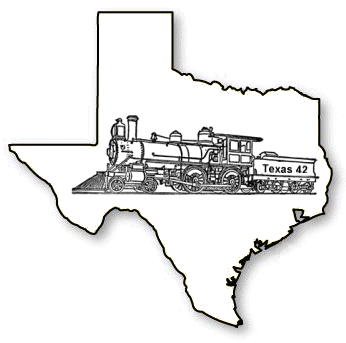
When automobiles were introduced into Texas in the early 1900s, subsequent paved roads and highways routinely followed the rail routes. Perhaps this reveals some heretofore subtle correlations. We might never know with certainty the origin of 42, but somewhere there is revealing documentation awaiting discovery.
Let's examine the historical expansion of select railways into the areas where most Texas42.net visitors resided in 2006/2007:
• 1856: The Houston and Texas Central Railway started in Harrisburg/Houston (Harris County) and began expanding to other areas in Texas.
• 1860: The Houston and Texas Central Railway was completed through Brazos County (home of Texas A&M in College Station where playing 42 is a college tradition).
• 1872: The Houston and Texas Central Railway connected to Dallas (Dallas County), Collin County, and Austin (Travis County).
• 1874: The Houston and Great Northern Railroad connected to Tyler (Smith County).
• 1876: The Texas and Pacific Railway connected Dallas to Fort Worth (Tarrant County), and the International-Great Northern Railroad (tracks from the Houston and Great Northern Railroad) connected to Williamson County (north of Austin).
• 1877: The Galveston, Harrisburg and San Antonio Railway connected Houston to San Antonio (Bexar County).
• 1881: The Texas and Pacific Railway and the Missouri, Kansas and Texas Railroad connected Denton County to Fort Worth and Dallas, respectively.
Note: The Texas and Pacific Railway connected Fort Worth to Weatherford (Parker County) in 1879. Weatherford is about 15 miles east of Garner which got its rail connection in 1891. (The domino game 42 reportedly originated in Garner in 1887.)
Harrisburg, now part of Houston, was possibly the earliest hub for rail propagation of 42 influence into other areas of Texas. This could explain a legend that 42 originated in east Texas, or it might not have any relevance whatsoever.
Windom in Fannin County was connected by rail to Dallas via Sherman in 1872. Since the reported co-inventors of 42 moved from Garner to Windom sometime after 1887, the statewide spread of 42 via rail could have started from those northeast Texas towns at about the same time. Houston and Austin might have been rail recipients of the game later on, rather than early on, following the Dallas area.
Or maybe the Aggies in College Station, many of whom were from rural areas, beat the then moral/legal bans on playing cards by improvising (or propagating) a domino game with bidding and trumps in the late 1870s or early 1880s, and it spread from there to influence the creation of 42-like games in other towns in the Texas rail system. Or maybe Methodist seminary students in Georgetown (north of Austin) were similarly creative during the same time period.
Innovative card game workarounds were likely prevalent in more than one Texas town in the 1800s. In the 1800s, "polite society" in the United States did not play card games, but they did substitute dominos to play card-like games. Regardless of how or where 42 started, early railways facilitated its spread to other areas before motor vehicles became widespread in Texas in the 1900s.
Lastly, when card playing finally did gain statewide acceptance, many post-World War II Texans found the convenience of a deck of cards preferable to a box of dominos. Those interested in bidding games might have reverted to established popular card games like Spades and Bridge. Now, with advances in technology and changes in culture, it will be interesting to see what games our grandchildren carry with them into their adult lives.
Paul Proft, webmaster
Texas42.net
31 March 2009
